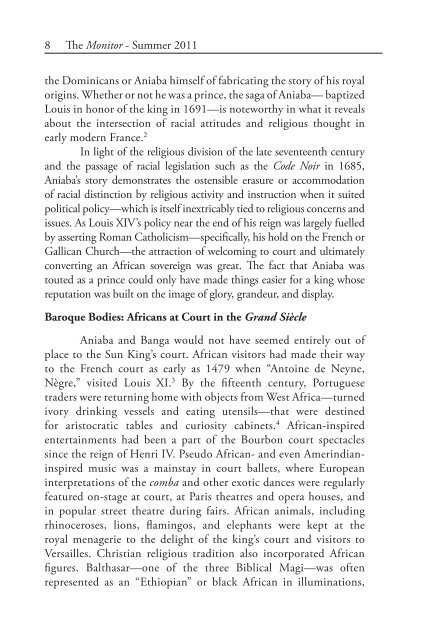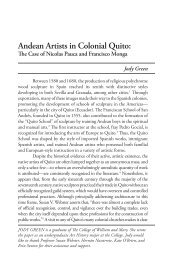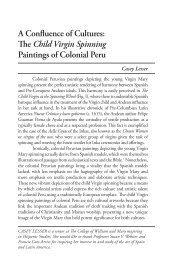African Prince at the Court of the - College of William and Mary
African Prince at the Court of the - College of William and Mary
African Prince at the Court of the - College of William and Mary
Create successful ePaper yourself
Turn your PDF publications into a flip-book with our unique Google optimized e-Paper software.
8 The Monitor - Summer 2011<br />
<strong>the</strong> Dominicans or Aniaba himself <strong>of</strong> fabric<strong>at</strong>ing <strong>the</strong> story <strong>of</strong> his royal<br />
origins. Whe<strong>the</strong>r or not he was a prince, <strong>the</strong> saga <strong>of</strong> Aniaba— baptized<br />
Louis in honor <strong>of</strong> <strong>the</strong> king in 1691—is noteworthy in wh<strong>at</strong> it reveals<br />
about <strong>the</strong> intersection <strong>of</strong> racial <strong>at</strong>titudes <strong>and</strong> religious thought in<br />
early modern France. 2<br />
In light <strong>of</strong> <strong>the</strong> religious division <strong>of</strong> <strong>the</strong> l<strong>at</strong>e seventeenth century<br />
<strong>and</strong> <strong>the</strong> passage <strong>of</strong> racial legisl<strong>at</strong>ion such as <strong>the</strong> Code Noir in 1685,<br />
Aniaba’s story demonstr<strong>at</strong>es <strong>the</strong> ostensible erasure or accommod<strong>at</strong>ion<br />
<strong>of</strong> racial distinction by religious activity <strong>and</strong> instruction when it suited<br />
political policy—which is itself inextricably tied to religious concerns <strong>and</strong><br />
issues. As Louis XIV’s policy near <strong>the</strong> end <strong>of</strong> his reign was largely fuelled<br />
by asserting Roman C<strong>at</strong>holicism—specifically, his hold on <strong>the</strong> French or<br />
Gallican Church—<strong>the</strong> <strong>at</strong>traction <strong>of</strong> welcoming to court <strong>and</strong> ultim<strong>at</strong>ely<br />
converting an <strong>African</strong> sovereign was gre<strong>at</strong>. The fact th<strong>at</strong> Aniaba was<br />
touted as a prince could only have made things easier for a king whose<br />
reput<strong>at</strong>ion was built on <strong>the</strong> image <strong>of</strong> glory, gr<strong>and</strong>eur, <strong>and</strong> display.<br />
Baroque Bodies: <strong>African</strong>s <strong>at</strong> <strong>Court</strong> in <strong>the</strong> Gr<strong>and</strong> Siècle<br />
Aniaba <strong>and</strong> Banga would not have seemed entirely out <strong>of</strong><br />
place to <strong>the</strong> Sun King’s court. <strong>African</strong> visitors had made <strong>the</strong>ir way<br />
to <strong>the</strong> French court as early as 1479 when “Antoine de Neyne,<br />
Nègre,” visited Louis XI. 3 By <strong>the</strong> fifteenth century, Portuguese<br />
traders were returning home with objects from West Africa—turned<br />
ivory drinking vessels <strong>and</strong> e<strong>at</strong>ing utensils—th<strong>at</strong> were destined<br />
for aristocr<strong>at</strong>ic tables <strong>and</strong> curiosity cabinets. 4 <strong>African</strong>-inspired<br />
entertainments had been a part <strong>of</strong> <strong>the</strong> Bourbon court spectacles<br />
since <strong>the</strong> reign <strong>of</strong> Henri IV. Pseudo <strong>African</strong>- <strong>and</strong> even Amerindianinspired<br />
music was a mainstay in court ballets, where European<br />
interpret<strong>at</strong>ions <strong>of</strong> <strong>the</strong> comba <strong>and</strong> o<strong>the</strong>r exotic dances were regularly<br />
fe<strong>at</strong>ured on-stage <strong>at</strong> court, <strong>at</strong> Paris <strong>the</strong><strong>at</strong>res <strong>and</strong> opera houses, <strong>and</strong><br />
in popular street <strong>the</strong><strong>at</strong>re during fairs. <strong>African</strong> animals, including<br />
rhinoceroses, lions, flamingos, <strong>and</strong> elephants were kept <strong>at</strong> <strong>the</strong><br />
royal menagerie to <strong>the</strong> delight <strong>of</strong> <strong>the</strong> king’s court <strong>and</strong> visitors to<br />
Versailles. Christian religious tradition also incorpor<strong>at</strong>ed <strong>African</strong><br />
figures. Balthasar—one <strong>of</strong> <strong>the</strong> three Biblical Magi—was <strong>of</strong>ten<br />
represented as an “Ethiopian” or black <strong>African</strong> in illumin<strong>at</strong>ions,








